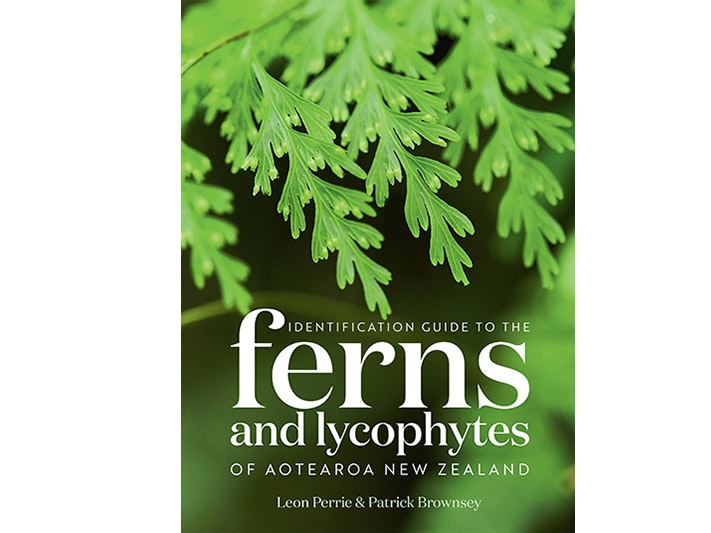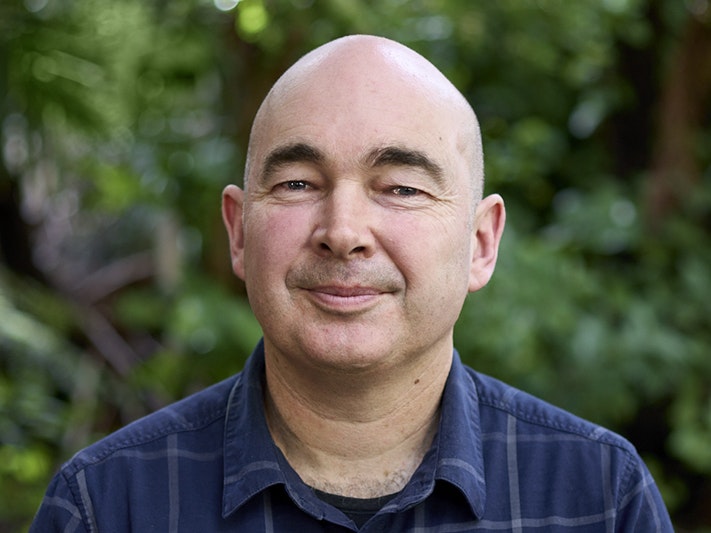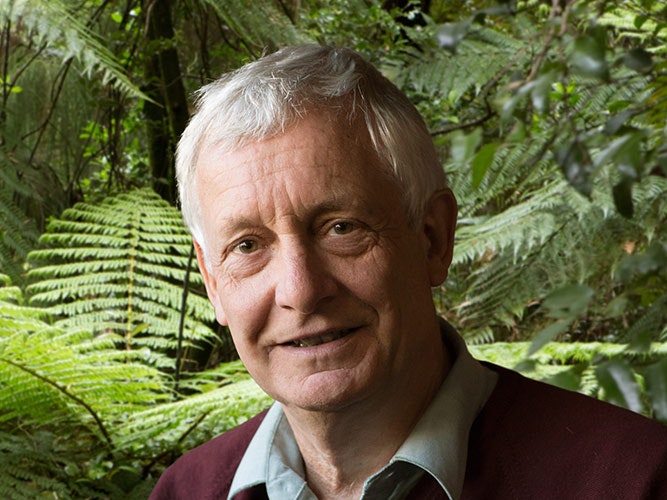Leon Perrie is Curator Botany at Te Papa and was the lead science curator for Te Papa’s long-term exhibition Te Taiao | Nature. Leon specialises in plant taxonomy, and the collection and curation of plant specimens. His research focuses on New Zealand’s ferns: their numbers, locations and identification, and using DNA analyses to understand how ferns are related to one another and to species overseas. He was a contributing author for the Ferns and Lycophytes series for the online Flora of New Zealand.
Leon Perrie. Photo by Yoan Jolly. Te Papa
"I think that being able to recognise the species around us strengthens our connection with them and with nature in general, and that can only be good." – Leon Perrie
Let’s start at the beginning – how did your interest in ferns come about?
There are a few parts to that. I grew up in a family that was often in the outdoors, especially my father. When I was high-school age, I was reading the book Prehistoric New Zealand, which included moa. They’re obviously an amazing animal and I was gutted that I’d never get to see one, which put me on the path of trying to better care for nature. That took me to university with an interest in biology, but my eyes were only opened to plants in a second-year course introducing the diversity of life. The two-part life cycle of land plants was a revelation, a seemingly alien phenomenon happening all around us. As part of this and similar courses, we had to prepare several collections of dried, pressed specimens of plants. I began to focus on ferns because they were easy to prepare as specimens since they were already flat. That initial expedient selection of ferns grew through postgraduate study into a career.
What makes them so special?
I’m not being coy or trying to be politically correct by saying that I think they’re not inherently more special or interesting than the rest of nature. However, they do have a special place in New Zealand culture, with ferns, particularly ponga silver fern, being one of our country’s nature icons, alongside the kiwi. That might have had its origins in the relative ecological prominence of ferns in Aotearoa. While we have comparatively few species of ferns compared to tropical regions, ferns are common in the New Zealand landscape. The prominence of ferns during the initial phases of human settlement of the country would have been further enhanced by the way some such as bracken proliferate after forest clearance.
How has our understanding of the variety of ferns across Aotearoa changed during your career as a botanist?
Two interrelated aspects: DNA and name changes. When I was at university about 25 years ago, the use of DNA analyses to study the interrelationships of ferns was in its infancy, but it is now the norm. While DNA analyses are not infallible, they can be very powerful, providing much more data for inferring relationships. This helps to delimit distinct evolutionary lineages that then can be recognised as separate species, and also for understanding how those species are related to one another. External appearance is still important, but these days it’s often more for recognising the delimited groups rather than driving the delimitation.
With name changes, some of this has been because species have been newly recognised or recorded for New Zealand. In other cases, it has been shown that the New Zealand population is the same as those overseas (or, conversely, different), and the name has changed to reflect that. But a lot of name changes relate to a different interpretation of how species are grouped into genera, which primarily affects the first part of the scientific name. The Identification Guide follows the scientific names that Pat and I used in the Flora of New Zealand – Ferns and Lycophytes. We were generally conservative there, making a change to the genus name only when a revised understanding of relationships showed the previous taxonomic classification to be wrong. However, other authors have proposed name changes when they were not strictly needed. These arguably superfluous names are listed in the Identification Guide, but we didn’t adopt them because our preference is to change names only when necessary. Even so, the revised understanding of fern relationships provided by DNA analyses has driven a lot of change to fern and lycophyte names.
This book was co-authored by Pat Brownsey, who sadly passed away at the end of last year. Can you tell us about Pat’s contribution to botany and Te Papa?
Pat studied New Zealand’s ferns and lycophytes for more than 40 years. One of his first research projects in New Zealand was to use chromosome number and pairing to untangle the Asplenium spleenwort group in which hybridisation is frequent. Moreover, many of the species have hybrid origins. Pat provided a solid framework for understanding a group that had previously been a web of confusion. Many people, including me, learnt ferns using Pat’s book New Zealand Ferns and Allied Plants (1989 and 2000 editions). Pat’s study culminated in him leading the Ferns and Lycophytes series of the online Flora of New Zealand (www.nzflora.info), which was finished in 2022, and is the definitive technical account of the ferns and lycophytes in New Zealand. Our Identification Guide is intended as a simpler and more accessible version of the Flora content. Among Te Papa’s botany collection, only two people have collected more specimens; he was a particularly extensive collector of mosses! Pat was, at various times, also manager of the museum’s natural history team. He was a significant professional and personal mentor to me and to others in Te Papa’s botany team and beyond.
You’ve been studying ferns for many years, contributing to the eFloraNZ and iNaturalist. What makes this book special in terms of how you share your work?
I’ve learnt how to distinguish New Zealand’s ferns and lycophytes through a combination of the opportunities afforded to me and hard work. The Identification Guide is a means to share that knowledge, and I hope a way of short-cutting the learning process for others, by focusing on what I understand to be the key characteristics for each species (described in words and shown in pictures). For those wanting to learn how to recognise our ferns, the Identification Guide is intended as the next best thing to having an expert alongside you.
Describe what a day out in the field might look like.
We’re in the field for about three weeks a year. On some field trips we are looking for particular species, and we might walk all day to get to a particular site to collect one or two specimens. On other trips, the goal is to document the diversity of a site. I remember a recent trip where five of us spent a day collecting mosses and liverworts – we only went about 200 metres, but we collected well over 100 species! A collecting day ends with readying the specimens to be pressed and dried; ferns and other big plants are placed into newspaper among a stack of cardboard.
What’s the most interesting location your research has taken you to?
Camping in mountainside jungle in the Solomon Islands. A temporary, generator-powered, mini village set among mud and snakes. I worked through one night to get specimens ready for an early-morning helicopter pick-up and was serenaded by a continuous din of frogs – I can’t remember the exact sounds, but it was definitely loud and didn’t end until dawn. I’ve also had the fortune to work in New Caledonia, Fiji, and Australia, and am well-travelled around New Zealand. I’ve recently begun helping with a project on taramea Aciphylla speargrasses, and it’s been interesting to get into their alpine habitat whereas most of my fern work has been in forests.
Do you have any favourite ferns?
I don’t have an enduring favourite. I do enjoy seeing species that are new to me (often that’s more about being able to recognise them as different rather than just simply seeing them). I’m now pretty familiar with New Zealand’s ferns (!), so the scope for my personal discovery lies more with other plant groups and overseas.
Is there a particular species that you wish people knew more about and to look out for?
Weedy ferns. Ferns are often thought of as fragile and delicate. But some are robust, and this applies to some of the overseas species introduced to New Zealand. The Identification Guide includes 22 species of fern and lycophyte that have naturalised here. Some of these are terrible weeds, capable of transforming their environment to the detriment of similarly sized (or smaller) native species. It would be great if more people appreciated that not every fern in the New Zealand environment is indigenous, and it would be useful if the problematic species were removed (or reported) when seen.
What do you hope that readers get out of this guide?
I hope they learn to see the different ‘faces’ of our many ferns. When I began learning about different plants, a forested hillside looked like a green blur. With the same vista, I now see the various characters (i.e., species) that make up that community, as well as understanding the role of each species within that community. I think that being able to recognise the species around us strengthens our connection with them and with nature in general, and that can only be good.


